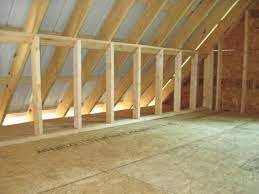Attic Insulation: Knee Walls & The Marvel of Cellulose
The world of attic insulation is vast, encompassing a range of materials and techniques. Among these, knee walls and cellulose insulation stand out for their unique benefits. This guide dives deep into the structural advantages of knee walls and the unparalleled moisture management capabilities of cellulose insulation.
Knee Walls: More Than Just Structure
Knee walls, often found in attics, are short vertical walls that support roof rafters and maximize the use of spaces that might be rendered useless due to slanting roofs. Beyond their structural role, knee walls have a significant impact on insulation. By insulating the space behind these walls, homeowners can achieve enhanced thermal protection, ensuring spaces remain comfortable and energy-efficient.
The Green Choice: Loose Fill Cellulose Insulation
As specialists in residential building science, we recognize the transformative power of the right insulation. With the rising prominence of net-zero and passive homebuilding, your insulation choice becomes paramount.
Loose fill cellulose insulation is not just a favored pick but also an efficient, sustainable one. Predominantly derived from recycled paper, it's a non-toxic solution that resonates with homeowners keen on eco-friendly home modifications. Its intrinsic nature to seamlessly fill all gaps in an attic guarantees a consistent layer of insulation, eradicating potential thermal bridges.
The attic, often overlooked, is a chief energy loss source. In winters, heat can escape without efficient insulation, while during summers, a properly insulated attic can deter hot air from infiltrating living areas. Choosing cellulose is a pledge to comfort, efficiency, and Earth.
Cellulose Insulation: A Moisture Management Powerhouse
Derived primarily from recycled paper products, cellulose is treated to be fire-resistant and is renowned for its splendid thermal and acoustic properties. But its mainstay is moisture management. The hygroscopic nature of cellulose allows it to wick moisture, averting damaging accumulations. Additionally, homes insulated with cellulose since the 1970s, sans vapor barriers, exhibit no signs of mold or structural impairment. Studies further corroborate that cellulose-insulated abodes maintain reduced moisture levels compared to those with vapor barriers.
Conclusion
Attic insulation is multifaceted. While knee walls bestow structural and insulation benefits, cellulose insulation provides unparalleled moisture management. Together, they furnish homeowners with a potent solution for a cozy, energy-efficient, and salubrious living environment. For more insights on energy conservation and green solutions, delve deeper into our blogs.


